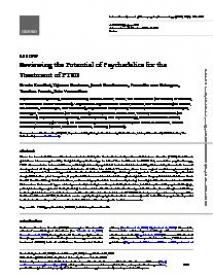Reviewing the Potential of Psychedelics for the Treatment of PTSD
There are few medications with demonstrated efficacy for the treatment of posttraumatic stressdisorder (PTSD). Treatment guidelines have unequivocally designated psychotherapy as a first line treatment for PTSD. Yet, even after psychotherapy, PTSD often remains a chronic illness, with high rates of psychiatric and medical comorbidity. Meanwhile, the search and development of drugs with new mechanisms of action has stalled. Therefore, there is an urgent need to explore not just novel compounds, but novel approaches for the treatment of PTSD. A promising new approach involves the use of psychedelic drugs. Within the past few years, two psychedelics have received breakthrough designations for psychiatric indications from the US Food and Drug Administration, and several psychedelics are currently being investigated for the treatment of PTSD. This review discusses four types of compounds: 3,4-methylenedioxymethamphetamine (MDMA), ketamine, classical psychedelics (e.g. psilocybin and LSD) and cannabinoids. We describe the therapeutic rationale, the setting in which they are being administered, and their current state of evidence in the treatment of PTSD. Each compound provides unique qualities for the treatment of PTSD, from their
use to rapidly target symptoms, to their use as adjuncts to facilitate psychotherapeutic treatments. Several questions are formulated that outline an agenda for future research.
Geachte bezoeker,
De informatie die u nu opvraagt, kan door psychotraumanet niet aan u worden getoond. Dit kan verschillende redenen hebben,
waarvan (bescherming van het) auteursrecht de meeste voorkomende is. Wanneer het mogelijk is om u door te verwijzen naar de bron
van deze informatie, dan ziet u hier onder een link naar die plek.
Als er geen link staat, kunt u contact opnemen met de bibliotheek,
die u verder op weg kan helpen.
Met vriendelijke groet,
Het psychotraumanet-team.
In: International Journal of Neuropsychopharmacology ISSN: 1461-1457 | 23 | 6 | june | 385-400
https://doi.org/10.1093/ijnp/pyaa018


